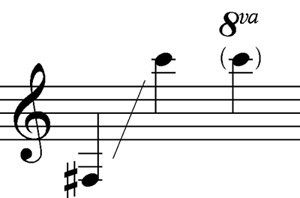 The Trumpet On The Staff
The Trumpet On The Staff
The trumpet range may be displayed in the treble clef as shown right.
The notes shown in the example are the written notes.
- Logically, on the B-flat trumpet the notes sound a tone lower.
- On the D trumpet, however, the notes would sound a tone higher.
Higher Notes In The Trumpet Range
On the B-flat trumpet, any notes up to the highest G can generally be produced with great confidence and across the range of dynamics. ie. Very quietly down to ppp or very loudly up to fff.
However, the very top notes up to the highest C should be utilized with care because they can be brilliant in effect but, if overused, can be straining on the ear.
NOTE: The C trumpet could be said to have an advantage over the B-flat trumpet when it comes to the highest register, in terms of tonal quality and intonation. This, for some time, caused the C trumpet to present a serious challenge to the supremacy of the B-flat instrument. Our page about Types of Trumpet goes into more detail.
Best Use Of The Trumpet Range – Examples
As we mentioned in our primary Trumpet overview page, there are some great examples of the trumpet’s range being used to marvellous effect.
Range Example 1
Here is Adolph “Bud” Herseth playing the opening trumpet solo from Gustav Mahler’s Symphony No. 5 under the baton of Sir Georg Solti in 1986. Herseth was a member of the Chicago Symphony Orchestra for over 50 years (1948-2001).
Range Example 2
It is not common to hear vibrato used on a trumpet, other than when it’s done so sparingly. However, there is always an exception to the rule and here is one we love to quote!
From the iconic movie “The Good, The Bad and The Ugly” where the trumpet solo composed by Ennio Morricone accompanies the final duel between the three protagonists at the end of the film. Played here by Andrea Giuffredi.